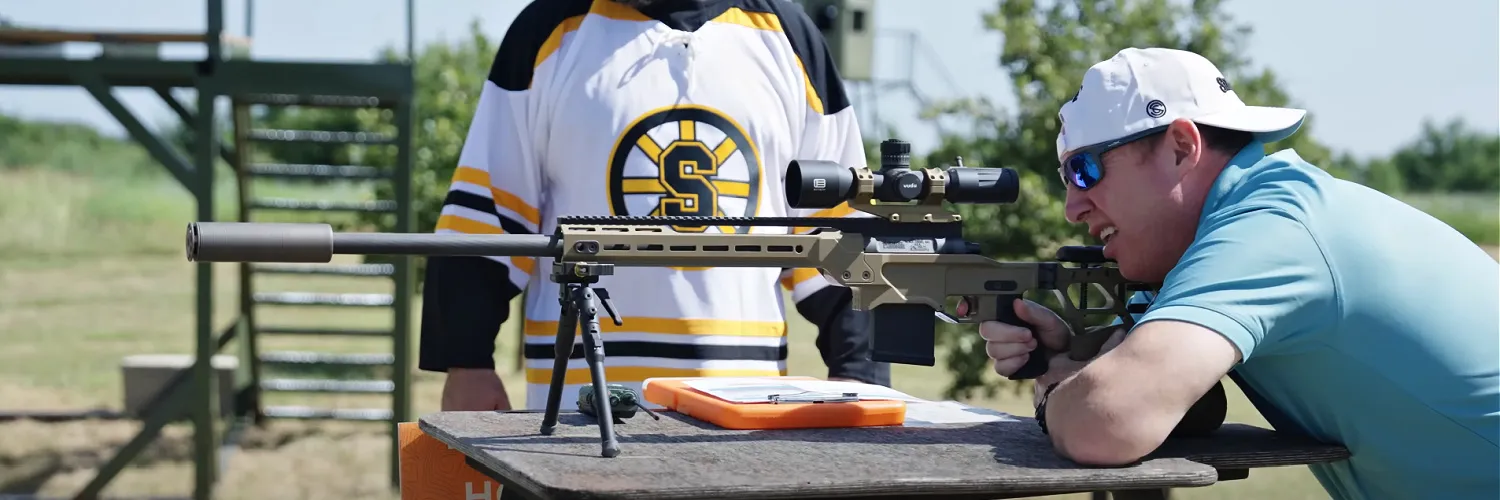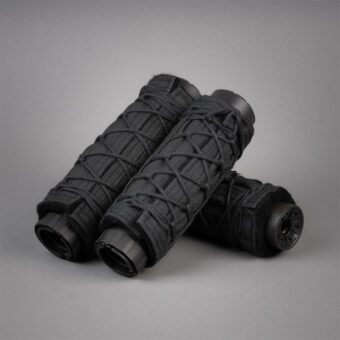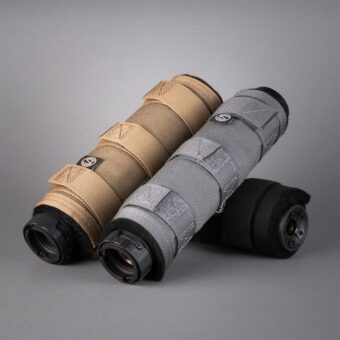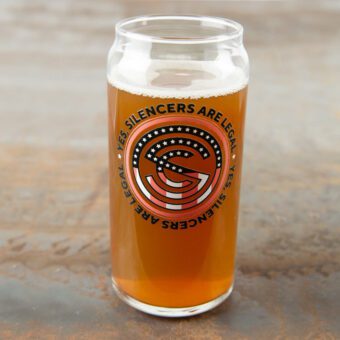What Do Suppressors Sound Like?
David Higginbotham
There’s a common misconception that suppressors make gunfire silent. Anyone who’s worked with suppressors knows this isn’t the case, but that hasn’t kept authors and movie makers from making them whisper quiet. In this exploration, we’ll do our best to dispel this myth and find a way to set realistic expectations.
How do we write about sounds?
I’ll begin with an explanation of the way we communicate. Those of us who have control of all five senses struggle to relate sensory experiences to others who have yet to experience them.
Comic book writers rely on onomatopoeia to relate sound. Thwack. Kawping. Zip. Buzz…. Gun writers do too, though we tend to give up too easily or get cute about it (pew pew).
The terms we might use to write about suppressed gunfire may seem even more strained when we think about the ways we describe unsuppressed gunfire. How many times has an ear-witness said gunshots sounded like fireworks?
I’m going to assume that those reading this know that different guns have different sounds. A .338 Lapua has a boom underneath an intense crack from the bullet breaking the sound barrier. Most .45 ACP is traveling just at or under the speed of sound, so it has a different bark. .22 Short is almost hearing safe from longer rifle barrels, and .22 Colibri is so quiet that fashionable elites often shot it in their parlors.
What Makes the Sound of a Gunshot?
There are four parts to the equation:
- The first (and one that is rarely noticed under the other sounds) is that of the primer popping. Pop a primer alone, though, and it may surprise you.
- Then there’s the ignition and rapid expansion of gasses leaving the barrel. This sonic blast is what I’d reductively classify as a boom, like any other explosion.
- As the bullet breaks the sound barrier outside of the barrel, it will create a sonic boom, which is higher and sounds more like a crack.
- Lastly, with semi-auto firearms, you may hear the sound of the action cycling.
In most cases, these sounds are layered and indistinguishable when your hearing protection is doing its job. But a suppressor is going to peel away the layers.
How Quiet Can a Suppressed Shot Get?
Let’s look at one example. Assume you are working with a bolt action .22 with a SilencerCo Sparrow 22 attached. Short of the pin striking the firing pin, this is a quiet set up.
How quiet? It depends on the ammo. With .22 LR — say CCI Mini-Mags — you still get a crack as the bullet leaves the end of the suppressor. There’s no way to silence a sonic boom completely.
But you can shoot subsonic ammunition, like CCI’s Quiet 22, and eliminate that issue. The Sparrow will eat up the expanding gasses, and cut that sound down tremendously. In that instance, there’s a muted noise that I’d spell out as ffft. The noise is as close to the Hollywood cliché as I’ve found, but less cutesy.
If you are working with someone who is sensitive to noise, this is an excellent tool. It is almost as if you remove that sensory shock from the equation. The result is a shot that is so silent that you can hear the rounds hit the target itself.
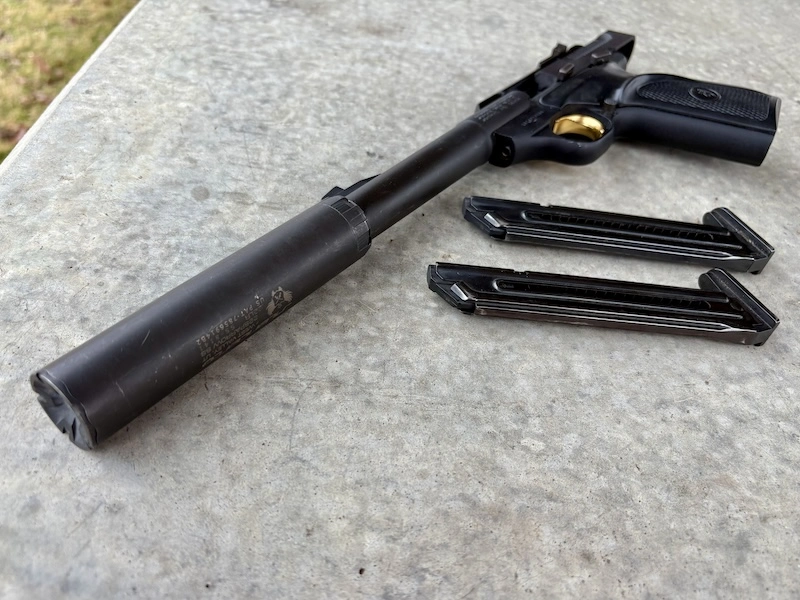
Subsonic Ammo and Terminal Ballistics
Whisper quiet shots are addictive. If I’m plinking, I like to shoot subsonic. There’s a trade-off, though. Sometimes. Terminal ballistics are determined by bullet design, but also by the speed and weight of the bullet. And subsonic rounds aren’t going as fast.
147 grain 9mm might sound great, but it is slow. You can find subsonic .308, even, but you give up the speed.
It is for this reason that many of us still choose to hunt with supersonic ammo, when there are subsonic options available.
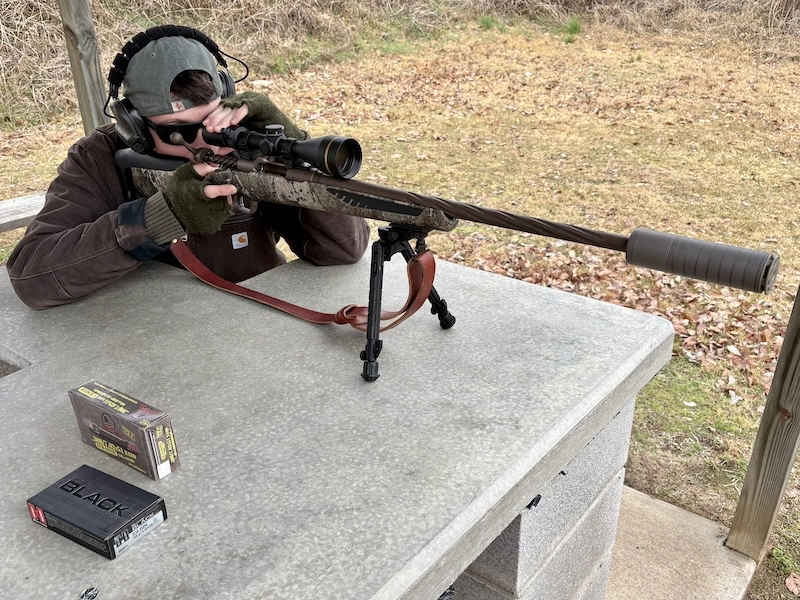
Can You Suppress Supersonic Ammo?
While it may not be as quiet, you can still suppress supersonic ammunition. This matters when hunting. Supersonic rounds can create hydrostatic shock — often immensely damaging wound channels formed by the sudden displacement of tissue and fluid. I could write a dissertation about this phenomenon, but I’ll reduce it to this: supersonic rounds have the potential to make more lethal wound cavities and to allow bullets to expand and deform, dumping more energy in the process.
Subsonic rounds just poke holes.
Here’s where the debate really ramps up. Sometimes just poking holes is still effective. Look at the lineage of the .45 ACP. Sometimes a big, fat, relatively slow bullet is enough. Sometimes you may want a fast-moving round with a flat trajectory to close long distances with reliable accuracy and enough momentum to harvest a whitetail ethically. One will be quieter than the other.
A suppressed .223, for example, or anything that breaks the sound barrier, will have a crack to it. That may sound loud—but it won’t be nearly as loud as the same shot unsuppressed.
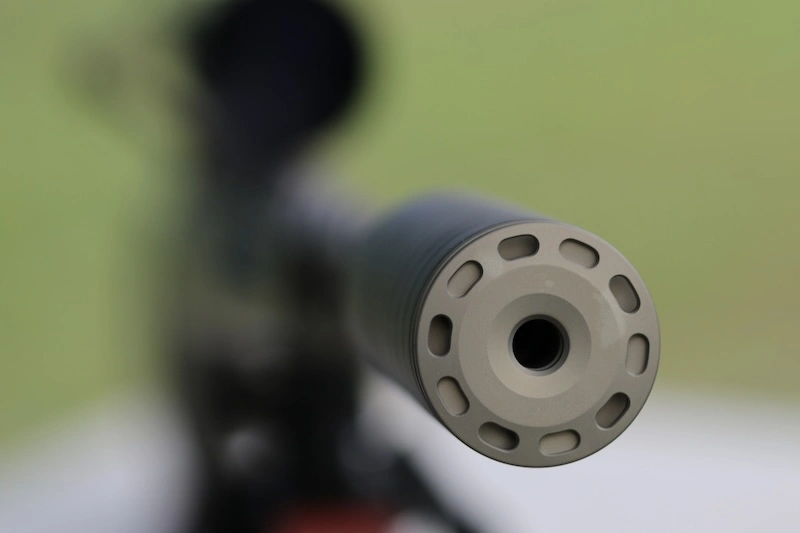
How Do Suppressors Reduce Noise?
Let’s remove the gun and ammo from the equation. Suppressors contain expanding gasses as they leave the barrel. Inside a can, baffles are purposefully designed to take that flow of hot gas and break it up, force it back on itself, and generally hold it long enough to let it cool a bit before it whisps out of the endcap.
Much of what determines how effective a suppressor can be relies on internal space. Baffle placement matters, too. Even the size of the hole in the endcap should be closely matched to the diameter of the projectile to keep extra gas from leaking early.
Suppressors like the Hybrid 46M are modular. You can build a long version that’s 7.72”. That extra length knocks off a few decibels. The shorter form, just over five inches, is easier to maneuver in brush. When I’m on the range, practicing, or hunting from a blind, the long configuration is my go-to. When I am stalking, I run shorter.
With a can designed to handle .46 caliber rounds, you can shoot a wide variety of rounds. The endcap with a .46” diameter hole seals off the large rounds better than it does .30 caliber rounds. Swapping out the larger end cap for a .30 caliber end cap will cut a few more decibels.
Look at the design, though, and it will begin to make sense. Silencer diameter is limited by practicality. They can’t be so wide that they block sights or optics. Designs like the Osprey use oblong shapes to build internal volume without blocking line-of-sight. The Scythe Ti, a suppressor that is ideal for bolt-action rifles, can be wider as most of these guns have scopes that ride higher above the bore.
There are other factors that come into play, though, too.
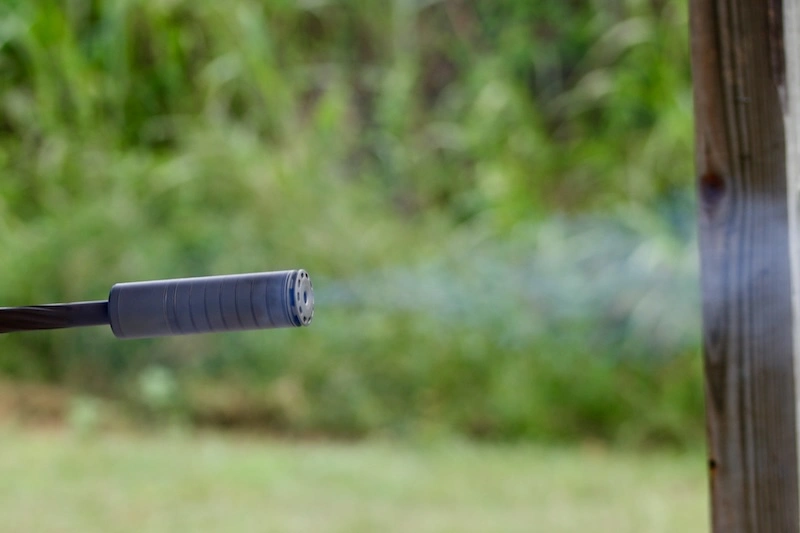
What Causes First-Round Pop?
The first time you fire a suppressed gun, or even if you wait a long stretch between shots, you may notice a pop that is louder than the shot that immediately follows it. Depending on the caliber and suppressor, this pop may be almost imperceptible—but with some can-and-ammo combinations, you’ll hear it.
This increase in sound comes from the oxygen inside the silencer. While there’s not much room for air inside, there is some. That space that catches the expanding gasses when a round is fired isn’t a vacuum. And oxygen is highly flammable. The gasses—which are already burning—hit that bit of air and get a small boost of energy. Pop.
Pull the trigger again, though, and you won’t get the same audible response. Follow-up shots are quitter because that empty space in the can is now filled with the exhaust of the first shot, which isn’t flammable to the same extent.
What Does Shooting Wet Do for Suppressors?
You can drop a few more decibels from a suppressed shot by shooting wet. Some use a capful of water. Some prefer wire-pulling gel. Either way, the addition of a small amount of liquid to the inside of a silencer adds another barrier that cools and disrupts the expanding gasses.
When the gun fires, the gasses are now hitting the baffles and pushing the liquid, which hits the baffles. It only takes a small amount to be effective. And it can increase the internal pressure, as there’s less room for the gas itself — so don’t go nuts.
Based on what we’ve outlined so far, it looks like there’s a way to predict what a suppressor would sound like. Take subsonic ammo in a bolt action rifle with an ample silencer with a bit of liquid in the baffles and you’re likely to have an effective combination.

What Doesn't a Silencer Sound Like?
Don’t take that question literally. The list would be too long. But you can see where I’m going with it.
Back in the fall, I hunted whitetail with my son. He’d shot his first deer with a suppressed .308 (167 grain Hornady Black). The buck had walked from the woods into a field, and then stood facing away from us. He lined up his shot and waited.
He held for more than three minutes. Though we were 225 yards out, the buck picked up our scent. He put his nose up and turned to the side just enough for a solid shot.
The shot, suppressed by the Scythe Ti, cracked and was followed by an audible thump from down range. That concussive hit of the round hitting the chest of the deer was a deep dull sound, but it was conclusive. There was no mistaking the sound of the hit. The buck bucked and bounded about 30 feet before he fell.
Sometimes, shooting suppressed isn’t about what you don’t hear but about what else you can hear.
Why Does Any of This Matter, Really?
Hunting suppressed has its obvious benefits. The benefits to your hearing, and the hearing of others should be obvious. But Hollywood insists on making suppressors sound like gentle whisps of wind — and that fuels public panic.
While an impossibly quiet shot in a spy film may make for a good plot point, it creates an expectation that feeds into the paranoia about literally silenced guns. This misconception that criminals are roaming the streets and gunning down people and no one can hear it remains as present today as it was before the creation of the NFA in the 1930s.
I’d like to think we’re past that by now. We’re not. But we can’t let misinformation kill off the obvious benefits that come from shooting suppressed responsibly.



